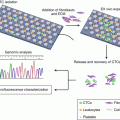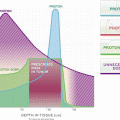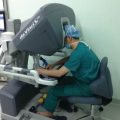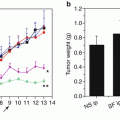, Nandie Wu1 and Jia Wei1
(1)
The Comprehensive Cancer Centre of Drum Tower Hospital, Medical School of Nanjing University and Clinical Cancer Institute of Nanjing University, 321 Zhongshan Road, Nanjing, 210008, China
8.1 Introduction
Gastric cancer is the fourth most common cancer and the second leading cause of cancer deaths worldwide [1]. Except countries such as Korea and Japan that have routine national screening programs, most patients with gastric cancer are in advanced stages of the disease as early-stage gastric cancers are usually without symptoms and often develop advanced stage even after radical surgery. Despite developments in the surgical treatment of gastric cancer, there is a relatively high recurrence rate. Specifically, the 5-year overall survival rate for all diagnosed patients averages 24.5% in Europe [2] and 40–60% in Asia [3, 4]. The main reason for post-surgery treatment failure for gastric cancer is peritoneal dissemination, which is caused by the seeding of free cancer cells from the primary gastric cancer. This is one of the most common types of metastasis for gastric cancer. Gastric cancer patients with macroscopic peritoneal metastasis have very poor prognoses, with a median overall survival of 3–6 months [5, 6]. In this chapter, we try to describe the influence of peritoneal metastasis on survival in patients with gastric cancer, the possible mechanism of peritoneal metastasis, and individualized treatment strategy of gastric cancer patients at high risk for developing peritoneal metastasis.
8.2 Peritoneal Metastasis in Gastric Cancer
The recurrence rate for gastric cancer remains high, especially in patients with advanced stages of the disease. In patients receiving radical surgery, 79% have recurrence within 2 years, and the median survival time from the time of recurrence is 6 months [7]. Many patients with gastric cancer (particularly those with Stage III disease) develop locoregional recurrence, peritoneal metastasis, or distant metastasis [8]. Although extensive research has analyzed recurrence patterns of gastric cancer after radical surgery, the data have yielded conflicting results. Schwarz et al. [9] found that most recurrences appeared diffusely at distant or peritoneal sites, and most locoregional recurrences occurred in conjunction with relapse at extraregional sites. Eom et al. [10] reported hematogenous metastasis as the most common pattern in patients with early recurrence, while locoregional and peritoneal recurrence occurred in patients with late recurrence 1 year after radical resection. This divergence was attributed to many reasons, such as differences in patient cohorts undergoing evaluation, methods for determining recurrence patterns, and the cutoff at which recurrence was determined. In addition, these results as well as those obtained from autopsy studies revealed only end-stage disease rather than early recurrences. Reoperation series likely display early locoregional and peritoneal recurrences. Peritoneal cytology and laparoscopy have been used to detect peritoneal metastatic disease not found in conventional imaging examinations [1].
A recent study of 1178 Korean patients with recurrent or metastatic gastric cancer demonstrated that about 46% of the patients had peritoneal metastases, while 30% had liver metastases [11]. Some clinical studies have found recurrence patterns in patients with early to advanced stages of gastric cancer, showing that 30–54% of patients had peritoneal recurrence alone or in combination with other site recurrence [7, 9, 12–14]. Our investigation with 349 patients with either Stage III or IV gastric cancer found that peritoneal metastasis was part of the metastasis or recurrence pattern in 62.8% of the patients. Of our total patient pool, 81.1% developed metastasis in the peritoneal cavity (peritoneal, liver, lymph node, ascites, or ovary) at the time of diagnosis or recurrence. Furthermore, our analysis showed that peritoneal metastasis was associated with poorer prognosis and poorer quality of life when compared with metastasis to other organs. Finally, patients with peritoneal metastasis had shorter survival time (7.5 vs. 14 months) and a higher risk of mortality (adjusted HR = 2.025, p = 0.004).
8.3 Mechanism of Peritoneal Metastasis
A recent comparative study proposed the following sequential steps for cancer cells to form peritoneal metastases: (1) penetration of cancerous tissues into the visceral serosa, (2) exfoliation of the cancer cells from the primary tumor site, (3) dissemination and survival of the cancer cells within the abdominal cavity, (4) adhesion of cancer cells to the peritoneum, (5) invasion of cancer cells through the peritoneal membrane, and (6) formation of the peritoneal metastasis [15]. However, the mechanisms dominating the formation of peritoneal metastasis remain relatively understudied. A global analysis was performed to find the differential gene expression of a gastric cancer cell line established from a primary main tumor and of other cell lines established from the metastasis to the peritoneal cavity. The expression patterns of approximately 21,168 genes were analyzed. Besides expression sequence tags, the investigators found that 24 genes were upregulated and 17 were downregulated [16].
Hiraki et al. [17] used a mouse model to demonstrate that loss of hypoxia inducible factor-1 alpha (HIF-1α) accelerated the development of aggressive peritoneal dissemination in gastric cancer cells by upregulating matrix metalloproteinases-1 (MMP-1) [17]. Matrix metalloproteinases-7 (MMP-7) tissue status in the primary tumor has also been validated as a good indicator for peritoneal metastasis. Patients with MMP-7-positive tumors had significantly shorter overall survival time and more frequently died of peritoneal recurrence than those with MMP-7-negative tumors [18].
Another broad analysis of differential gene expression between the parental cell line GC9811 and its highly metastatic peritoneal counterpart, cell line GC9811-P, confirmed that recombinant human S100 calcium-binding protein A4 (S100A4) and cadherin-associated protein beta 1 (CTNNB1) were upregulated. Moreover, tensin homolog deleted on chromosome ten (PTEN) and phosphatase was downregulated in GC9811-P cells. Identification of these differentially expressed genes could help uncover the underlying mechanisms and provide new targets for therapeutic intervention to avoid peritoneal dissemination of gastric cancer [19]. A recent comparative study demonstrated that advanced gastric cancer patients with a large amount of intraoperative hemorrhage were more likely to develop peritoneal recurrence, maybe due to the increased ability of cancer and mesothelial cells to adhere to each other in the presence of plasma factors [15]. Iroquois homeobox protein (IRX1) [20] and zinc protoporphyrin IX (ZnPPIX) [21] were also confirmed to inhibit peritoneal metastasis via neovascularization. Ultimately, identification of these differentially expressed genes will lead to a better understanding of the molecular mechanisms for peritoneal metastasis and provide new targets for therapeutic agents to avoid peritoneal dissemination of gastric cancer.
To date, P38-mitogen-activated protein kinase (MAKP) inhibition by a targeted small molecule inhibitor has been shown to be effective in preventing the peritoneal dissemination of poorly differentiated gastric cancer. It does so by acting at multiple checkpoints in the process of attachment and diffusion of tumor cells in the peritoneum [22]. Chemokine receptor 5 (CCR5) antagonism can reduce the potential risks of gastric cancer cell dissemination [23]. Nevertheless, the mechanisms of peritoneal dissemination for gastric cancer need to be further examined to lend more insights for peritoneal metastasis therapy.
8.4 Selected Patients for Intraperitoneal Chemotherapy
Positive peritoneal cytology has been classified as M1, metastatic disease in the Seventh Edition of the American Joint Committee on Cancer (AJCC) Staging System for gastric cancer [24]. Free intraperitoneal cancer cells isolated during peritoneal washing in patients with gastric cancer have been reported to be independently and significantly correlated to prognosis, influencing both recurrence-free survival time and overall survival time. It is, therefore, imperative to prevent peritoneal recurrence after radical surgery to improve the prognosis of patients with gastric cancer. The recent progress in treatment is the administration of intraperitoneal adjuvant chemotherapy soon after resection in patients with high risk of peritoneal recurrence [25, 26]. Then the question becomes: What kind of patients may benefit from this therapy, and what kind of patients are at high risk of peritoneal recurrence?
Although the exact mechanism promoting peritoneal recurrence remains controversial, the presence of malignant cells in the peritoneum at the time of surgery leads to peritoneal recurrence [27, 28]. Therefore, tests of peritoneal fluid may be used to identify patients with a high risk of peritoneal recurrence after radical surgery.
The standard and reliable method for detecting free cancer cells in the peritoneal washing fluid and for predicting peritoneal metastasis is conventional peritoneal cytology. However, large-sample studies have revealed that about 4–11% of patients will have positive peritoneal cytology. Therefore, it is neither practical nor cost-effective to perform this test on all patients [29]. Therefore, the sensitivity for the detection of residual cancer cells and prediction of peritoneal spread is not high enough [30, 31]. A recent prospective clinical study suggested that conventional peritoneal cytology test was not very reliable in predicting peritoneal recurrence after radical surgery for patients with gastric cancer, as peritoneal washing cytology was predictive of both peritoneal recurrence and survival time in patients with gastric cancer [32].
Another recent study involving 655 patients examined intraoperatively assessments of macroscopic serosal changes, which were defined as changes in color or nodular texture of the serosal surface on inspection and palpation. Their results showed that such examination led to a poorer prognosis and increased peritoneal recurrence risk for patients with curatively resected gastric cancer. Macroscopic assessment of serosal changes may be a useful indicator that allows for better risk stratification of patients with resected gastric cancer considering both peritoneal recurrence and prognosis [14].
In the last few years, genetic detection using reverse transcriptase polymerase chain reaction (RT-PCR) analysis has been observed to be more sensitive than conventional cytology. The target genes included carcinoembryonic antigen (CEA), zinc finger E-box-binding homeobox 1 (ZEB1), melanoma-associated gene (MAGE), cytokeratin 20, MMP-7, telomerase, and heparanase, and alone or in combination was used as potent molecular markers for the detection of peritoneal metastasis [33–35]. We also detected CEA mRNA in peritoneal washing fluid of gastric cancer patients after radical surgery and found that CEA mRNA was a more sensitive measure to detect peritoneal metastatic disease than peritoneal cytology. The positive rate of CEA mRNA was correlated with either T stage or N stage in patients with gastric cancer.
However, the amplified mRNA may derive from phagocytes or dead cells that engulfed tumor cells and later released it from hematopoietic cells in an inflammatory context [36]. Therefore, the issue of clinical false-positive cases has yet to be addressed. Using DNA methylation or flow cytometry to identify intraperitoneal tumor cells is other valuable alternative for selecting patients who might have a high risk for peritoneal metastasis [37, 38].
8.5 Effective Treatments for Patients with Peritoneal Metastasis
Of patients with gastric cancer, 20–50% who underwent curative surgery will develop postoperative peritoneal recurrence [39]. Intraperitoneal spread of tumor cells is also observed in 54% of gastric cancer patients who died of recurrence after radical surgery [40]. Gastric cancer patients with peritoneal metastasis have a very poor prognosis. Systemic chemotherapy may improve median overall survival time in metastatic gastric cancer by 7–10 months. However, patients with peritoneal carcinomatosis do not show similar improvements [41].
Until now, hyperthermic intraperitoneal chemotherapy (HIPEC) has been the most widely accepted strategy for the treatment of peritoneal metastasis, which is the most frequent metastatic pattern in patients with gastric cancer [42]. The theoretical advantage of HIPEC is to add the direct cytotoxic effects of heat in high concentrations of the cytostatic drug [43, 44]. In addition to the mechanical washing effect, HIPEC also has a theoretical superiority in delivering a higher concentration of anticancer drug into abdominal cavity with reduced systemic toxicity. There are many molecular explanations for these HIPEC effects, such as alterations of cell membrane properties, induction of apoptosis, changes to intracellular proteins and their synthesis, and inhibition of DNA repair enhanced by inhibitors of the cellular heat-shock response [45, 46].
In gastric cancer patients with peritoneal metastasis, surgical treatments that directly remove the primary lesion of peritoneal dissemination are a palliative approach. The combination of cytoreductive surgery (CRS) and HIPEC was first proposed in 1980 by Spratt [47]. After that, Sugarbaker and his team extensively applied this innovative technique for peritoneal carcinomatosis [48]. Some Phase II–III clinical trials revealed that patients with peritoneal metastasis who received CRS and HIPEC had better survival results only if complete cytoreduction (CCR-0) resection was achieved. However, the survival benefit of HIPEC remains low when cytoreductive surgery cannot accomplish sufficient down staging of the carcinomatosis burden [36, 49]. A retrospective study in France that involved 159 patients confirmed the combinatorial advantage in selected CCR-0 groups of patients [50]. The unsatisfactory effect of HIPEC in patients with extensive peritoneal carcinomatosis who were not amenable to down staging to CCR-0 may be explained by a more limited drug penetration ability. This would lead to negligible antitumor effects on the deeply invasive microfoci [51]. Therefore, drug delivery systems with high permeability have a promising, future role in the treatment of extensive peritoneal carcinomatosis patients [52].
8.6 Optional Drugs for Intraperitoneal Treatment
Multimodal treatment strategies have been used to improve the prognosis of gastric cancer patients with peritoneal metastasis. However, the results remain unsatisfactory [53]. The oral chemotherapeutics S1 is a polypharmaceutic, fluoropyrimidine derivative that combines tegafur with two modulators, gimeracil, and oteracil. A recent meta-analysis demonstrated that the use of S1 monotherapy was associated with a significant survival benefit for patients with gastric cancer [54]. The advantage of S1 over other chemotherapeutic agents is in its ability to achieve higher intraperitoneal concentrations. This is due to the higher concentrations of 5-fluorouracil (5-FU) and CDHP achieved in peritoneal tumors relative to plasma [55, 56].
In addition to S1, both docetaxel and paclitaxel also have high sensitivity against diffuse-type adenocarcinoma, which is the most common type of peritoneal tumor. This is due to their ability to bind to tubulin and lead to microtubule stabilization and mitotic arrest. Importantly, some of these compounds can be transported into the peritoneal cavity when administered intravenously [57].
Numerous studies have evaluated intraperitoneal drug delivery in gastric cancer patients, especially in patients with peritoneal metastasis. Intraperitoneal administration of chemotherapeutic agents makes it possible for an extremely high concentration of drugs to directly contact the target cancer lesions in the peritoneal cavity. However, intraperitoneal administration of cisplatin or mitomycin C has not shown significant therapeutic effects against peritoneal metastasis of gastric cancer due to its immediate absorption through the peritoneum [58]. In contrast, intraperitoneal administration of paclitaxel has been demonstrated to enhance antitumor activity against peritoneal metastasis by maintaining a high concentration of the drug in the peritoneal cavity over a long period. A number of convincing clinical trials have confirmed its clinical effects in ovarian cancer with peritoneal metastasis. These superior results were due to the pharmacokinetic advantage of taxanes after regional delivery [59]. Taxanes are absorbed through the openings of the lymphatic system, such as the stomata and the milky spots. These are important sites for the formation of peritoneal dissemination [60], due to their large molecular weight and fat solubility [61]. A Phase I/II study of intraperitoneal docetaxel plus oral S-1 for gastric cancer patients with peritoneal carcinomatosis showed a superior 1-year overall survival rate of 70%. Moreover, peritoneal cytology was negative in 81% of patients [62]. Along similar lines, Fujiwara et al. reported a median survival of 23.6 months in Japanese gastric cancer patients with peritoneal carcinomatosis who had been treated with intraperitoneal docetaxel combined with oral S-1 [63].
Intraperitoneal paclitaxel has shown a profound pharmacokinetic advantage of increased intraperitoneal concentration of the anticancer agent 1000 times higher than intravenous administration of paclitaxel at the same dose. However, the main problem of intraperitoneal chemotherapy is the limited penetration depth of anticancer drugs directly into the tumor. Therefore, the optimum use of paclitaxel may consist of both intraperitoneal and intravenous administrations, since intraperitoneal paclitaxel reaches systemic circulation only in small amounts [64]. In fact, Ishigami et al. established intraperitoneal paclitaxel with oral S-1 plus intravenous paclitaxel as an advantageous means of systemic chemotherapy. Furthermore, a Phase II study reported an overall response rate of 56% among patients with target lesions and a decrease or disappearance of malignant ascites in 62% of these patients [61].
Another recent Phase II clinical trial in serosa-positive gastric cancer patients showed a similar response rate of 71.4%, with 3- and 5-year overall survival rates of 78 and 74.9%, respectively [57].
Also, the efficacy of intraperitoneal irinotecan has been demonstrated in several animal studies. The AUC ratio of SN-38, the bioactive metabolite of irinotecan, varied between 3.7 and 14.8. This depended on the concentration of the administered irinotecan [65]. Moreover, pemetrexed has been considered a viable option when used intraperitoneally in a Phase I trial in both ovarian cancer and diffuse malignant peritoneal mesothelioma [66, 67].
In addition to chemotherapeutic agents, catumaxomab, a rat-mouse hybrid monoclonal antibody, was registered for the treatment of malignant ascites of various epithelial cell adhesion molecule (EpCAM)-positive malignancies, including ovarian, gastric, breast, and colorectal cancer. Two studies have shown that this drug improved progression-free survival in patients with gastric cancer (median 71 vs. 44 days, p = 0.03). Moreover, that it improved survival in gastrointestinal anti-EpCAM-positive tumors when administered intraperitoneally [68, 69].
Conclusion
Gastric cancer is the second leading cause of cancer death worldwide, and more than half of the patients with gastric cancer are found disease progression of peritoneal carcinomatosis and die from it. Proper selection of intraperitoneal chemotherapy in patients with peritoneal metastasis or a potential risk of peritoneal recurrence may be a promising approach to improve the prognosis of advanced gastric cancer cases. Chemotherapeutic agents with high concentration and high permeability in the peritoneal cavity are optimal choices for intraperitoneal chemotherapy and cooperate with systemic chemotherapy. Moreover, future research on potential biomarkers from peritoneal washing could provide valuable information in selecting subsequent treatment combinations.
References
1.
Leake PA, Cardoso R, Seevaratnam R, Lourenco L, Helyer L, Mahar A, Rowsell C, Coburn NG. A systematic review of the accuracy and utility of peritoneal cytology in patients with gastric cancer. Gastric Cancer. 2012;15(Suppl 1):S27–37.CrossRefPubMed
Stay updated, free articles. Join our Telegram channel

Full access? Get Clinical Tree







